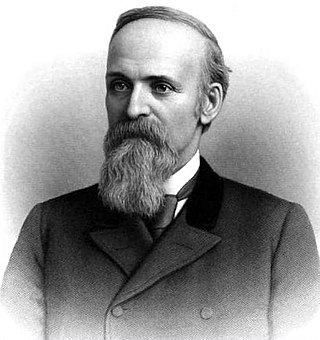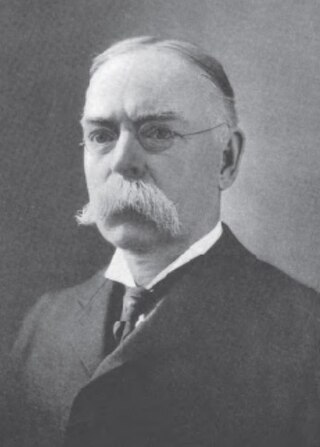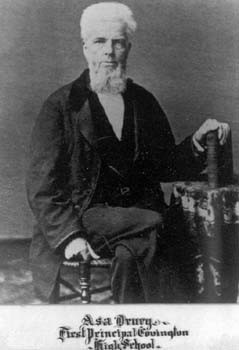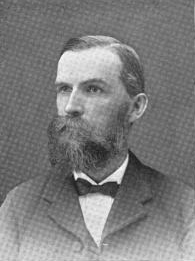Related Research Articles

Henry Mower Rice was a fur trader and an American politician prominent in the statehood of Minnesota.

Elias Howe Jr. was an American inventor best known for his creation of the modern lockstitch sewing machine.

Edmund Rice was an American politician. Rice served in the U.S. Congress in Minnesota's 4th District from March 4, 1887, to March 3, 1889.

George Fuller was an American figure and portrait painter.

John Coolidge was an American executive, businessman, and entrepreneur with the New York, New Haven and Hartford Railroad. He was the first son of Calvin Coolidge, the 30th president of the United States (1923–1929) and Grace Coolidge, the First Lady of the United States from 1923 to 1929.

John Bachop Gilfillan, known as J.B., was a Minnesota politician and lawyer active in the late 19th century.

Americus Vespucius Rice was a nineteenth-century politician, banker, and businessman from Ohio. He served in the Union Army during the American Civil War and was appointed brigadier general at the end of the war, on May 31, 1865. From 1875 to 1879, he served two consecutive terms in the United States House of Representatives.
Levi Hubbard was a U.S. Representative from Massachusetts. Born in Worcester in the Province of Massachusetts Bay to Jonas Hubbard and Mary (Stevens) Hubbard, he attended the common schools. He moved to Paris in Massachusetts' District of Maine in 1785, where he farmed and served in local offices including selectman and treasurer of Oxford County.
The Howe family is a family of politicians from the United States. Below is a list of members.

Alexander Rice Esty was an American architect known for designing many Gothic Revival churches in New England. His work also encompassed university buildings, public buildings, office buildings, and private residences across the Northeastern United States.

William Ball Rice was an American industrialist who co-founded Rice & Hutchins, a shoe manufacturing company with main offices in Boston, Massachusetts. He served as president of the company from its founding in 1866 until his death.

Henry Rice was an American Army officer in the War of 1812, a leading Boston merchant, a member of the Boston City Council and a member of the Massachusetts House of Representatives.

Asa Drury (1801–1870) was an American Baptist minister and educator primarily teaching at Granville Literary and Theological Institution in Granville, Ohio, and the Western Baptist Theological Institute in Covington, Kentucky, and establishing the public schools in Covington. He is best known for his antebellum abolitionist views and his role in establishing the Underground Railroad in Ohio.

Simon Herbert Howe was a Massachusetts businessman and politician who was the first mayor of Marlborough, Massachusetts, and a member of the Massachusetts House of Representatives. He also served as a member of Marlborough's Board of Selectmen, chairman of Marlborough's School Committee, and as a member of the Massachusetts Governor's Council.
Gardner Howe was a farmer from Dover, Vermont and member of the Vermont House of Representatives, serving in 1816 and 1823.
Jonas Howe (1786–1854) was a farmer and school teacher from Petersham, Massachusetts and member of the Massachusetts House of Representatives, serving in 1845.
Marshall Otis Howe was a farmer, school superintendent and Justice of the Peace from Newfane, Vermont and member of the Vermont House of Representatives, serving in 1882.
Arthur Otis Howe was a dairy farmer and electrical engineer from Newfane, Vermont and a Republican member of the Vermont House of Representatives, serving from 1931 to 1933 and then reelected in 1937 and 1945. He also served in the Vermont Senate from 1947 to 1948.

William Rice was a Massachusetts businessman and public servant, a member of the Massachusetts House of Representatives and a Registrar of deeds and Treasurer for Hampden County, Massachusetts.
References
- 1 2 3 4 "Jonas Holland Howe (1786-1865) in Howe Family of Massachusetts". Political Graveyard. Retrieved 25 May 2012.
- 1 2 3 Edmund Rice (1638) Association, 2011. Descendants of Edmund Rice: The First Nine Generations, Edmund Rice (1638) Association. (CD-ROM)
- 1 2 3 4 5 Geske, Norman A. 1950. A pioneer Minnesota artist. Minnesota History Magazine 31(2):99-104. web access
- 1 2 "A leader in Plymouth's formation by Gary Scheibe". Lakeshore Weekly News 12 April 2010. Retrieved 30 May 2012.
- ↑ Carpenter, Laura Howe Reminiscences of Pioneer Life. undated pamphlet 64pp. The Hennepin County Historical Society, Minneapolis. Some of Negus's portraits are noted in Somebody's Ancestors, a catalogue of an exhibition of paintings by primitive artists of the Connecticut Valley, held in the Springfield Museum of Fine Arts from February 7 to March 8, 1942.